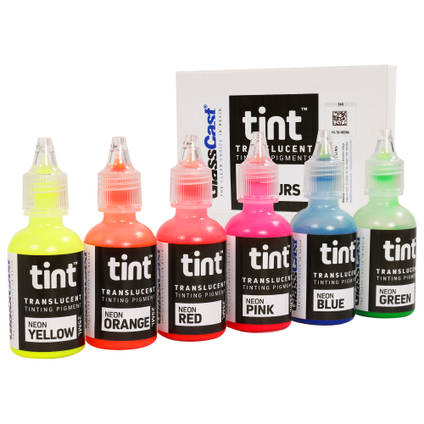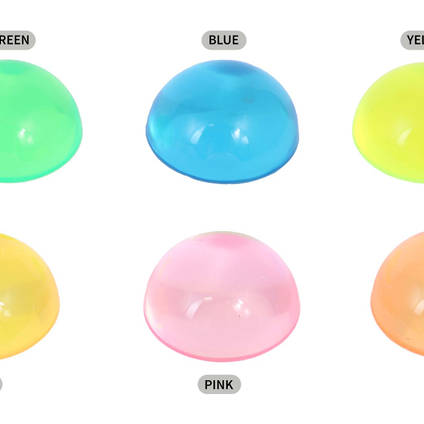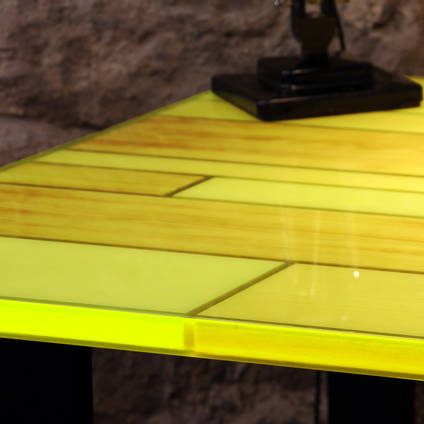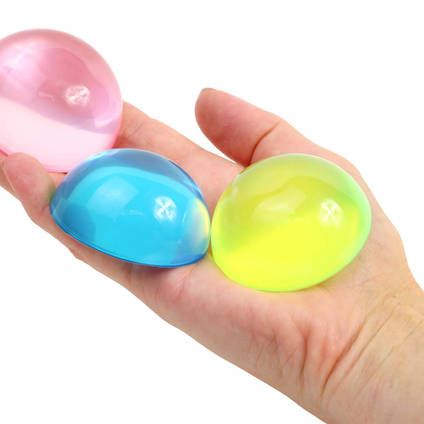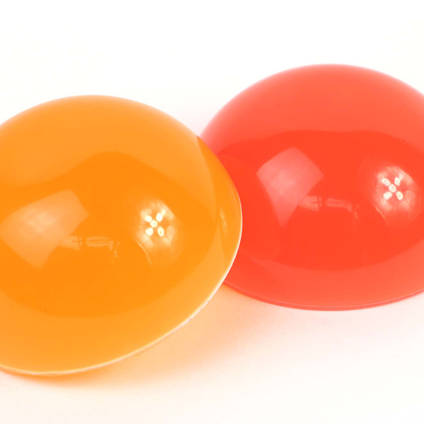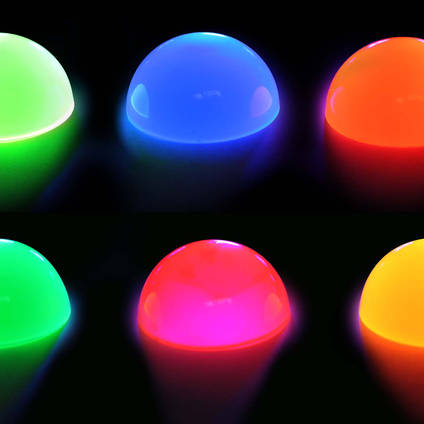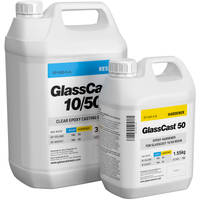Need any help or advice?+44 (0)1782 454499
Downloads (1)
| Safety Datasheet (SDS) |
Specification
General Properties
| Gross Weight | 0.228 | kg |
|---|
Shipping Information
Restrictions
This product is not classed as dangerous goods for transport and can be shipped to all destinations without restriction.
Shipping to EU countries is now done through our European subsidiary based in the Netherlands. All EU customers should use www.easycomposites.eu.
Package Size
There are no package size restrictions or surcharges for this product.
Delivery Cost
To find the delivery cost of this item to your address, add it to your basket and then use the instant shipping calculator on the basket page.
Set of 6 Neon Translucent Tinting Pigments
- PG-TR-NEON6
- No reviews
This set of 6 neon colour tints can be used to add a day-glo/luminous translucent (see through) colour to most clear casting resins including epoxy, polyurethane and polyester. Add just a few drops to create a subtle tint or add more to create a stronger colour.
Set of 6x 25ml bottles. Contains: Neon Red, Neon Orange, Neon Yellow, Neon Pink, Neon Blue, Neon Green.
AVAILABILITY:Out of Stock
New stock is on its way. If you order this product, your whole order will be held and then dispatched to you as soon as this product is back in stock.
New stock is on its way. If you order this product, your whole order will be held and then dispatched to you as soon as this product is back in stock.
We won’t be beaten on price!
If you believe you’re buying an equivalent product cheaper elsewhere, contact us to discuss your requirements.
Set of 6 stunning neon pigment colours (fluorescent / day-glow) translucent tinting pigment intended to add a vivid bright neon colour to clear casting resins like GlassCast, ArtResin and most other polyester, polyurethane and epoxy casting resins. The neon tints also glow under UV light to produce dramatic effects.
Only a few drops of these special day-glow tints are needed to add translucent colour effects to resin castings and so each 25ml bottle is sufficient to tint large quantities of resin.
This pack of 6 eye-popping neon colours includes:
- 25ml Neon Red
- 25ml Neon Orange
- 25ml Neon Yellow
- 25ml Neon Pink
- 25ml Neon Blue
- 25ml Neon Green
Resin Compatibility
These translucent pigments are compatible with:
- All GlassCast clear epoxy resin systems
- ArtResin safe, clear art coating epoxy
- Polyurethane casting resins (such as our Waterclear Polyurethane Casting Resin)
- Waterclear polyester casting resins
- Epoxy resins
They have been tested with products from our own range but should also work well with resins from other manufacturers however you should always conduct your own tests as to their compatibility with other resin systems.
How to Use
As stated above, when 'tinting' clear resins the key is to use only a tiny amount of these translucent pigments. 1 droplet is enough to pigment around 20-40g of resin, depending on how strong you want the colour tint to be.
Remember that thicker castings will require a lower percentage of pigment because the tint will appear stronger the thicker the section is. Conversely, thinner castings will require a higher percentage of pigment in order to appear to be the same colour as thicker castings.
Tinting Mix Ratio Table
Since most electronic scales are incapable of the accuracy required to measure pigment ratios of around 0.005% we would suggest using the table on the specification tab as a guide, but in all cases experimenting yourself adding a tiny amount of pigment at a time until you achieve the desired level of tint:
Dispersing the Pigment
The pigments disperse very quickly into epoxy resin and polyurethane resin. When using the pigments to tint larger quantities of polyester resin it is recommended to make a resin 'dispersion' by mixing the pigment into a small amount of the resin first and then mixing the small pigmented batch of resin into the larger batch to aid distribution of the pigment throughout the resin.
When pigmenting more reactive materials such as fast curing polyurethanes you will find it helpful to mix the pigment into one side of the resin (either part A or part B) thoroughly before mixing the two parts together and starting the reaction. This allows as much time as is needed to thoroughly disperse the pigment before starting the reaction. If you do choose to pigment just one side of the resin first it's helpful to remember that the addition of the second half of the resin will 'dilute' the tint when you add it.
Set of 6 stunning neon pigment colours (fluorescent / day-glow) translucent tinting pigment intended to add a vivid bright neon colour to clear casting resins like GlassCast, ArtResin and most other polyester, polyurethane and epoxy casting resins. The neon tints also glow under UV light to produce dramatic effects.
Only a few drops of these special day-glow tints are needed to add translucent colour effects to resin castings and so each 25ml bottle is sufficient to tint large quantities of resin.
This pack of 6 eye-popping neon colours includes:
- 25ml Neon Red
- 25ml Neon Orange
- 25ml Neon Yellow
- 25ml Neon Pink
- 25ml Neon Blue
- 25ml Neon Green
Resin Compatibility
These translucent pigments are compatible with:
- All GlassCast clear epoxy resin systems
- ArtResin safe, clear art coating epoxy
- Polyurethane casting resins (such as our Waterclear Polyurethane Casting Resin)
- Waterclear polyester casting resins
- Epoxy resins
They have been tested with products from our own range but should also work well with resins from other manufacturers however you should always conduct your own tests as to their compatibility with other resin systems.
How to Use
As stated above, when 'tinting' clear resins the key is to use only a tiny amount of these translucent pigments. 1 droplet is enough to pigment around 20-40g of resin, depending on how strong you want the colour tint to be.
Remember that thicker castings will require a lower percentage of pigment because the tint will appear stronger the thicker the section is. Conversely, thinner castings will require a higher percentage of pigment in order to appear to be the same colour as thicker castings.
Tinting Mix Ratio Table
Since most electronic scales are incapable of the accuracy required to measure pigment ratios of around 0.005% we would suggest using the table on the specification tab as a guide, but in all cases experimenting yourself adding a tiny amount of pigment at a time until you achieve the desired level of tint:
Dispersing the Pigment
The pigments disperse very quickly into epoxy resin and polyurethane resin. When using the pigments to tint larger quantities of polyester resin it is recommended to make a resin 'dispersion' by mixing the pigment into a small amount of the resin first and then mixing the small pigmented batch of resin into the larger batch to aid distribution of the pigment throughout the resin.
When pigmenting more reactive materials such as fast curing polyurethanes you will find it helpful to mix the pigment into one side of the resin (either part A or part B) thoroughly before mixing the two parts together and starting the reaction. This allows as much time as is needed to thoroughly disperse the pigment before starting the reaction. If you do choose to pigment just one side of the resin first it's helpful to remember that the addition of the second half of the resin will 'dilute' the tint when you add it.
Downloads (1)
| Safety Datasheet (SDS) |
Specification
General Properties
| Gross Weight | 0.228 | kg |
|---|
The quantity of resin used in the pigment dispersions is very small and as such when the pigment is mixed into another resin, the additional amount of resin from the pigment is very small and in practical terms insignificant. As such you do not normally need to account for it within the mixing ratio calculations.
No, unfortunately you cannot use a pigment from one resin type with another resin type. You must use the correct pigment for the resin type you are using - eg a PU resin needs a PU pigment, a polyester resin needs a Polyester pigment and an epoxy resin needs an epoxy pigment.
This is because the pigment dispersions are a blend of pigment powders AND a small amount of base resin. Mixing the wrong pigment with a resin system may inhibit the resin cure and damage the end product
Yes, you can use the pigments in a resin infusion process, however if you are not using a gelcoat you will still get the colour from the fibre showing where it contacts the surface, with glass fabric the effect is diminished as the fibre is clear, but with densely coloured fibre like carbon it may affect the pigment.
If you need a very solid colour for epoxy infusion I would advise using Polyester Pigment in the GC50 Epoxy Compatible Gelcoat.
When using a pigment paste, it is best practice to mix the paste into the resin part of the mixture. We recommend doing this before adding the catalyst/hardener as it means you have as much time as you need to get a good even colour mixture without having to worry about reduced pot life.
The pigments used in this pigment dispersion will be excellent in terms of light fastness and weathering characteristics. If you are not already aware, pigments are graded for these properties on a blue wool scale, with 7-8 being the best. We tend to only source such grades for our dispersions with such high quality. However, the base resin system you are using these pigments with may be vulnerable to UV yellowing itself.
No, they have NOT been tested on animals and contain NO animal ingredients or animal derived ingredients.
Our tinting pigments have a good level of UV resistance. In the several years we have used and tested them we have not seen any measurable degradation due to UV exposure. However, like all inks and pigments, eventually over many years we would expect a small and gradual degradation as no inks are 100% UV stable.
Drop into our trade counter to see some samples which are still looking very vibrant a few years on!
Although our Translucent Tinting Pigments are classed as non-toxic, they do not carry any specific food safety approval.
These pigments have NOT been tested on animals and contain NO animal ingredients or animal derived ingredients.
Yes, absolutely. All of our range of Translucent Tinting Pigments can be used with our GlassCast range of resins.
No, these Tinting Pigments are NOT suitable for use with Cyanoacrylate based adhesives. This is because the pigments are oil based and oil can cause curing and strength issues when mixed into Cyanoacrylates.
Yes, absolutely. These translucent tinting pigments are ideal for use with the GlassCast range of clear casting epoxies. The pigments are very much designed to be translucent and thus you would see any objects embedded within the resin however, the more pigment you add, the deeper the tint and eventually with enough pigment you could make the resin opaque.
No, the Neon Tinting Pigments do not glow in the dark; they're 'day-glow' only. They will, however, glow when exposed to UV/Black light and of course also look luminous in daylight.
Yes the pigments will remain fluorescent with the UV being backlit. The exact effect, light spread and intensity will depend on a variety of factors such as intensity of UV light, shape of object diffusing light, intensity of pigments and ambient light conditions.
ASK YOUR OWN QUESTION
Customer Product Reviews for Set of 6 Neon Translucent Tinting Pigments
SUBMIT YOUR OWN PRODUCT REVIEW
We publish all reviews for verified purchases. Submit your own review and help other customers with their choices.SUBMIT YOUR OWN PRODUCT REVIEW
We publish all reviews for verified purchases. Submit your own review and help other customers with their choices.Shipping Information
Restrictions
This product is not classed as dangerous goods for transport and can be shipped to all destinations without restriction.
Shipping to EU countries is now done through our European subsidiary based in the Netherlands. All EU customers should use www.easycomposites.eu.
Package Size
There are no package size restrictions or surcharges for this product.
Delivery Cost
To find the delivery cost of this item to your address, add it to your basket and then use the instant shipping calculator on the basket page.
CUSTOMERS ALSO PURCHASED
CUSTOMERS ALSO PURCHASED
100% SECURE
PAYMENT METHODS


Easy Composites Ltd, registered in England 7486797. All content copyright (C) Easy Composites Ltd, 2024. All rights reserved.
